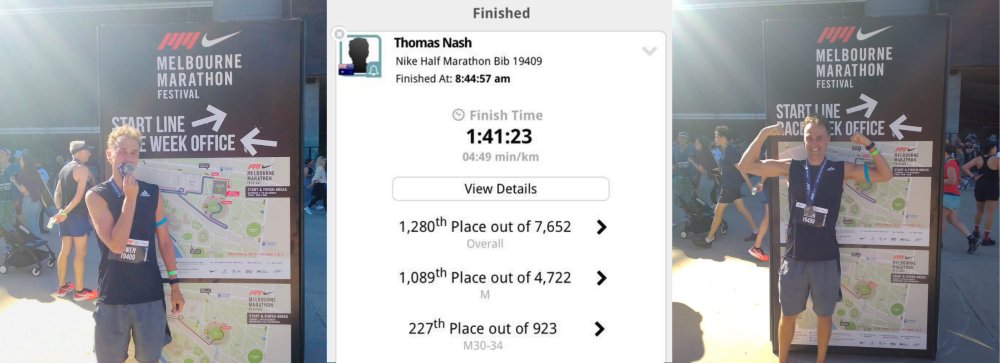The science behind enjoyable marathon running
Written by: Tom Nash
(View Author Bio)
Marathon? Enjoyable? Yes, it can be. The amount of planning and training involved for a marathon can be overwhelming and daunting at first. However, being aware and applying Behavioural Economic principles can help simplify the process and overcome an array of mental and physical hurdles. Marathon running can be enjoyable, let me break down the theory and share my tips with you – you may even want to sign up for the next half or full marathon by the end!

The Science of Happiness, Motivation and Meaning
Who would ever want to run a marathon? Am I crazy for doing this? Where do I start? What do I do? Why do I want to put myself through this pain? These were the questions I asked myself the day I decided to sign up for a marathon. As Professor of Behavioral Economics Dan Ariely puts it, “an alien who arrived on Earth just in time to witness one doing a marathon might think, ‘These people are being tortured while everyone else watches. They must have done something terrible, and this is their punishment.’”
It didn’t take me long to realise why people go through such discomfort, to achieve a challenging but inspiring goal. What drives people to overcome and accept the discomfort, sacrifice and stress, is the human need to pursue purpose and meaning. Social psychologist Roy Baumeister concluded that pursuing meaning is often associated with increased stress and anxiety. People have a unique continuous need to find meaning, driving us to achieve our full potential.
The quest for purpose and meaning is no different in the workplace. What drives employee motivation? Employees are looking for more than “just a job” and are seeking work that’s personally meaningful. Employees who see value in the purpose and mission of their company will work harder to bring it to life each day.
The impacts of are well articulated by Maslow's hierarchy of needs, a theory in psychology proposed by Abraham Maslow in his 1943 paper “A Theory of Human Motivation”. The study highlights that humans are never static, eager to reach self-actualisation - a person comes to find a meaning to life that is important to them. There is an abundance of studies out there on the human need to find meaning and purpose, and its impact on motivation.
My purpose of signing up to a half marathon was to challenge myself and achieve something meaningful, but determining the initial steps to succeed was difficult. There were so many elements that required a great deal of attention just to get started and to ensure I continuously improved, from diet, sleep, the training routine and missing the occasional social event. Thankfully being aware and applying Behavioral Science principles gave me the kick start and motivation to achieve my goals.
Heuristics and Choice Architecture
There was a lot going through my head the day I officially signed up for the grueling half marathon. What do I do? How am I going to do this? How do I even train for a marathon? There were so many thoughts running through my head and decisions to make. I became overwhelmed.
As humans, we prefer to take the simplest path when making decisions and selecting our goals. This is referred to as heuristics. When there are too many factors involved in making a decision we become scattered, losing the ability to use familiar rules of thumb, shortcuts, and tricks of the trade to help find the path. Feeling overwhelmed with having to make too many decisions and choices is known as tyranny of choice. To overcome this, I took the time to break it all down into 3 simple blocks: training, recovery, and diet. I concisely gave myself a clear direction by setting a plan that was easy to follow and encourage healthier habits, this is known as choice architecture. Popularised by Nobel laureate Richard Thaler, the idea is that the environment and presentation of choices affects the likelihood of desirable decisions. Thinking about everyday examples - keeping a water bottle at my desk, it was a simple way to ensure I stay well-hydrated. Setting reminders on my Fitbit to move and stretch throughout the day. If you do meal preps on the weekend for the week ahead, then you are already being your own choice architect!
With my goals and steps to follow made straight forward, it gave me focus and confidence to plan out and start my journey. It pushed me in the right direction and boosted my intrinsic motivation (internal motivation).
The Dopamine Effect
Reaching a level of intrinsic motivation was a huge tick at the beginning of my journey, but I needed to maintain the motivation to stay on track and constantly improve considering 3km runs was the norm for me. Knowing that people produce a behaviour when they know they will be rewarded for doing it (extrinsic motivation), I did just that. I rewarded myself frequently for achieving significant milestones. When I progressed to a new distance and improved my time, I gave myself rewards that were meaningful, known as hedonic rewards – rewards that stimulate visualisation and evoke emotions. From tangible rewards such as buying new running gear to a cheeky chocolate bar, to more experience type rewards like cooking myself a big feast (couldn’t say no to a big homemade gourmet pizza), to going out with friends. Much of the research indicates that tangible items and experiences have a deeper connection emotionally than other reward types (such as cash / gift card rewards) – it seemed like a good reason (excuse) to extrinsically motivate myself consistently throughout the entire journey anyway.
The feeling I got from achieving challenging milestones and rewarding myself for it is known as the dopamine effect. The “rush” people feel after something good happens. It is a powerful emotive response because human behaviour is triggered by emotion. In fact, our research in the science of applied Behavioural Economics tells us that emotion trumps reason 77 percent of the time. Humans are much more engaged and motivated when there are consistent opportunities to be rewarded.
Recognition and Making it Social
Humans are socials beings. We crave social interaction and social experiences in our everyday lives due to the fact we are more emotional than rational. Advice I received from a friend who had completed a marathon told me to share my entire experience. This made sense to me seeing that social motives are influential in encouraging behaviours and making celebratory moments more memorable. I used social motives such as affiliating with other runners and sharing my journey with friends and family.
Every now and then I made the effort to go on casual runs with friends or train with those doing the upcoming marathon. The benefit of this approach was I was able to compare my performance to others. It activated my competitive nature and allowed me to evaluate and compare my progress. If I performed well in comparison, I felt good, if I underperformed in comparison, it gave me motivation to improve. This is known as relativity bias, where people put a value on something by comparing it to something else.
I instantly noticed my friends and family became interested in my journey. They were intrigued on what distance I was running and my average time per kilometer. In my initial stages of training, I was running an average time per kilometer of 5.05min/km at 10km distances, then over time I got to 4.40min/km then 4.10min/km. As I started to share my times and my progression to longer distances, the recognition from them became constant. The power of recognition has a strong ripple effect on productivity, happiness and motivation, which I experienced firsthand. These same principals are relevant in any workplace, individuals who expect recognition for future achievements feel a greater obligation to work hard, give a higher proportion of their full effort, find ways to improve in their role, and deliver more of their best ideas to the company.
Receiving frequent praise from friends and family was very beneficial but on top of that, sharing and celebrating my achievements with them created a much more memorable experience, known as sociability. Sociability helps build motivation to produce that behaviour again, and in my case it drove me to take my efforts to the next level, which is referred to as hedonic treadmill, seeking to take our performance to the next level. I wanted to run longer distances, improve my average time per kilometer and show if off.
The Final Stretch of my Journey
With 4-6 weeks to go, I noticed my attentiveness to improve lifted significantly. From my experience it was driven by a mix of emotions where the nerves starting to kick in, the built up of excitement as the race wasn’t too far away, the realisation that time was flying faster than I wanted and whether I was doing enough. There were behavioural economic principles behind this such as loss aversion, prospect theory and goal gradient theory.
The concept behind loss aversion is people feel the pain of loss more strongly than the pleasure of a gain. Some studies show the pain of losing is psychologically about twice as powerful as the pleasure of gaining. This is part of prospect theory, where people make decisions based on the potential gains and losses. For me I had worked tirelessly for some time, and I was becoming fearful of not performing my best the day of the half marathon and even afraid of not completing it. I feared losing all I had gained and worried about the possibility of failing. As I got closer and closer to the date of the half marathon, I became more focused and produced more effort to prevent the pain of loss. This is a common reaction all humans have called goal gradient theory – the closer people get to a goal, the more effort they put into meeting it.
The Result
If you are reading this right to the end, you must be wondering what time I ran? Luckily all my hard work of planning, following strict routines and training paid off. I ran the half marathon in 1:41:23, it was better than I expected. I didn’t expect to run it in less than 2 hours and below 5.00 min/km, but sometimes you can surprise yourself if you put in the work. The feeling after completing it was a sense a fulfillment and relief. My knowledge of behavioral science allowed me to tackle expected and unexpected challenges and implement behavioural based strategies, that I hope would be helpful for your own training.
Considering our emotional nature and need to pursue meaningful / purpose, the same strategies are effective in a variety of situations from behavioural change, shifting motivation, introducing effective recognition & rewards, improving wellbeing to lifting productivity.

















